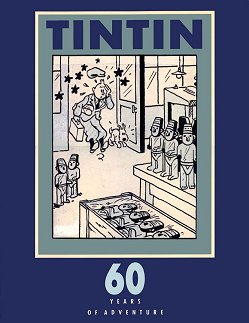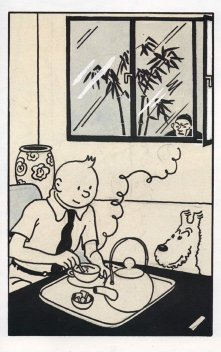Tintin: 60 Years Of Adventure
- Exhibition Catalogue cover

- Image © Hergé/Moulinsart.
Kings Road, Chelsea, London SW3, 1989. Yuppies and Sloane Rangers breeze past the Town Hall, ears glued to their oversize mobile phones, blissfully unaware that inside something incredible was about to take place. It was a beautiful August, but I was to spend more than two weeks of it cooped up inside, working everyday from 10am til’ 8:30pm. But I didn’t mind. It was Tintin!
It all started when I saw a job advertised in the window of the Tintin Shop in London (then known as “Pilot”). It said that they needed some people to work at the first Tintin exhibition in London. I was a bit late, but I took an application form and sent it off. 2 days later, I received a phone call telling me to get down there right away.
I was lucky to get the job actually; it was only because somebody had to pull out, plus the fact that they were impressed with my application form, which I’d drawn and coloured like a Tintin strip; it featured Tintin explaining why I should have the job. A former colleague that worked in the shop later told me that it was framed and hung on the wall of the London office! (The office has now sadly gone - wish I still had a copy of that application!).
The job involved being a monitor, i.e. standing in a different part of the exhibition for half an hour at a time in rotation, with a half-hour’s sit at the end. After the first few days of continually being on my feet, my back ached (and everybody else’s, probably), so I tried doing a bit of yoga. One morning, before we opened, the chief lieutenant monitor came through the exhibition as usual to check we were all in place and found me lying on the floor in the corpse position. I assured him I didn’t have a hangover and he was on his merry way.
Having had the rare pleasure of spending 16 days rotating around the exhibition, some of the images stored within my memory are still vivid. So for the benefit of all those that missed it, here’s a short tour.
After paying your £2 entrance fee, or 50p for children and OAPs, we leave the Town Hall foyer and enter a low ceiling enclosure lit by spotlights, where just inside the door a statuette bust of Tintin greets us. On the wall beside it is the very first page of Soviets. More plates of the same lead you along a corridor. They’re larger than the books, somewhere towards A3 size. Some think this early style too crude and edge their way toward the beautifully painted gouache cover of Congo.
After continuing along the corridor, past a few ink pages of America and Cigars you suddenly find yourself in a large circular room - the walls lined with the entire inks of The Blue Lotus!
- The Blue Lotus ink

- Image © Hergé Moulinsart.
This is the centrepiece of the entire exhibition. Hergé takes on a new style; the pictures, with their delicate ink lines and blue tint wash shading almost look Chinese. Nothing can compare to the originals! One amazing thing is how white the pages look. The Hergé Foundation are certainly looking after the archives, maybe even a bit too much… Far Eastern art and culture is very much in vogue at this time. The organisers of the exhibition even use a quote by the Chinese Philosopher Lao Tzu as part of a multi-media display in the foyer.
Glass cabinets stand strategically placed throughout the exhibition, displaying ‘artefacts’- the book “Moscou Sans Voiles”, a sceptre, model of the Unicorn, etc. Photography is forbidden. Some people make sketches under the disdainful look of the organisers. “Why’s it all in French?” someone asks.
On we go, past some cut-up and re-jigged pages (for the later version of the books) of The Broken Ear to some colour pages of the original The Black Island. This is a small revelation. Remember, most English fans are ignorant at this point of a lot of the work, as well as the actual order of the books. Now it’s all starting to make sense.
After that the style changes again; Hergé just seems to get better. More black and white inks of Ottokar are followed by 2 ink pages from the first Land of Black Gold, including the last drawn page of that version, unpublished at the time because of the invasion of Belgium in 1940. Those last pages, which show the German Müller leaving Tintin to his fate in a sand storm, seem strangely resonant with the time.
Haddock enters the frame next in the original ink of his very first appearance in Crab beside which stands a display of crates containing crabmeat tins (but is it crabmeat??) Further along from this, a glass cabinet shows off some early colour blueprints for The Shooting Star, representing the change to the new format for the books.
- Crab with the Golden Claws ink

- Image © Hergé/Moulinsart.
The Unicorn and Red Rackham pages that come next show an obvious progression in Hergé’s technique, despite the imposed size restrictions. Some tiny strips of Unicorn from Le Soir illustrate this point.
There isn’t much of The Seven Crystal Balls and Prisoners of the Sun; just 2 inks and a few preparatory sketches. Shame, because Prisoners is my favourite book. Then it’s off to the moon, represented by some large ink boards, which show copious amounts of black ink dotted with tiny white spots.
At last we come to the pièce de résistance. A small crowd has gathered around one of the exhibits, drawn there perhaps by the strange light emanating from it, rather like the walls in the Temple of the Sun. It’s the pencil sketch cover to Tintin in Tibet, surrounded by many other similar beauties from the same book. Marvelous doodles litter the edges of the pictures; some of them I became intimate friends with when hardly anybody came in on a Monday morning.
I’m afraid there was nothing after that except Alph-Art, which I thought at the time stood out, although most people casually strolled past those crude rough sketches. It almost seemed as if Hergé was rushing to get it finished before … the end came …
And that was it, bar some voluntary help taking down the exhibition lights, etc. We didn’t touch the work! Lots of French and Belgium people came down and carefully stacked and packed them, then took them away to be locked in a dark vault somewhere in Belgium until who knows when.
And so off we all went to the pub to spend our money (we didn’t get paid until the end), with strong legs and happy memories.
Text © Chris Owens. Used by permission. Images © Hergé/Moulinsart.
